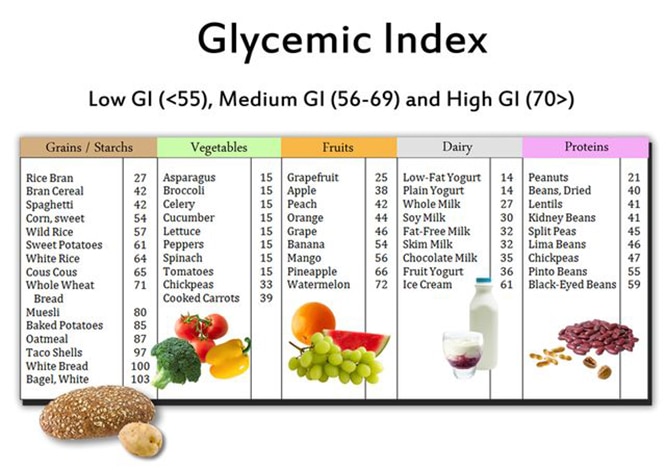 5-star Fitness
5-star Fitness
 5-star Fitness
5-star Fitness

The glycemic Index is a scale to compare how your body breaks down and digests the carbohydrates we consume. Or more importantly, how fast a food raises your blood sugar.
The scale is ranked from 0 to 100. Foods that quickly raise your blood sugar are higher on the scale and foods that do not raise the blood sugar as quickly are much lower on the scale. Our goal is to stay for the most part below 60 with the foods that we consume, especially for individuals with diabetes needing to put extra effort into managing their blood glucose.
What are the Negative Effects of a High Glycemic Diet?
When you consume a higher GI (Glycemic Index) scored food, it spikes your blood sugar. Your body then creates the hormone Insulin to balance out the blood sugar. Having too much insulin produced by the body triggers your body to store more fat. If your body is constantly having to produce insulin to fight high blood sugar, your pancreas eventually tires out and you become Insulin resistant, which eventually leads to weight gain, taking drugs like Metformin to manage, and eventually, type II diabetes.
How are foods ranked on the GI Scale?
Foods that range 70 or above are considered HIGH on the GI scale.
For example:
white flour bread
tortillas
mashed potatoes
sugary foods like cookies and doughnuts.
Foods that range 56 to 69 are considered MEDIUM on the GI scale.
For example
bananas
white rice
sweet fruit like papaya and mango
Foods that range from 0 to 55 are considered low GI foods.
For example
brown rice
whole grains
lower sugar fruits like green apples and berries and legumes.
What affects the GI of food?
Excerpt taken from the American Diabetes Association
Fat and fiber tend to lower the GI of a food. As a general rule, the more cooked or processed a food, the higher the GI; however, this is not always true.
Below are a few specific examples of other factors that can affect the GI of a food:
FYI on Potatoes
It can get a bit confusing, so here is a bit more info on the potato as sweet or russet, it is a staple in most family dinners.
The White potato is 69 on the GI scale with the skin, it is 98 without the skin.
This is because the fiber in the potato skin slows down digestion.
The Russet Potato is 111
The Red Potato is 89
The Nicola potato is 58
The Sweet potato is 44 boiled
A Yam steam or boiled is 35
A sweet potato is a great choice over a regular potato because it is much higher in Vitamin A and Potassium! And you don’t need all of the butter and sour cream to make it taste good! The take away is that how you prepare your potato is important.
What are the benefits of following a low GI food plan?
Consuming foods lower on the GI scale will help keep your blood sugar balanced, and will help you to maintain a healthy weight. In addition to weight management, a low glycemic diet benefits you in numerous ways!
I can’t emphasize enough how important it is to maintain a low glycemic diet to our guests struggling with weight loss and type 2 diabetes. Once you get the hang of it, it’s easy and you will discover new foods you never knew you loved!
To get you started, here is a PFC favorite recipe, the Low Glycemic Banana Muffin